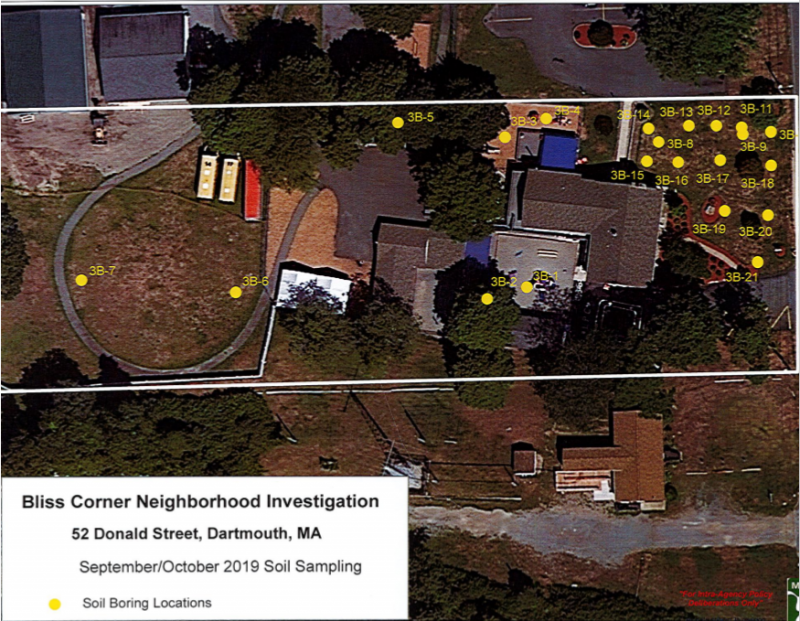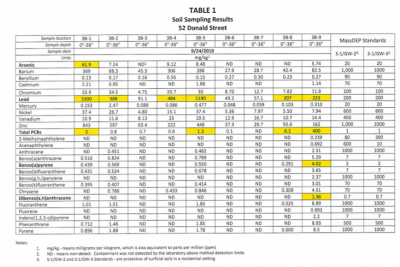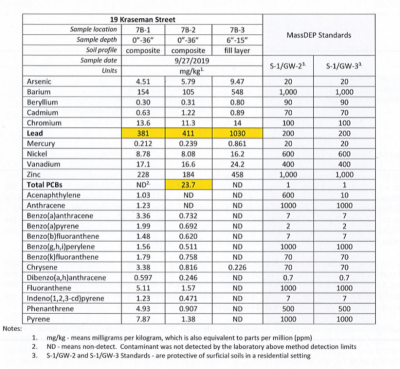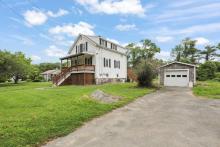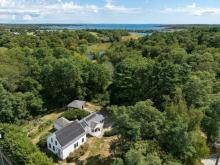Chemicals ‘imminent hazard’ at two Bliss Corner properties
Two more properties in Bliss Corner — including a daycare — have dangerously high levels of contaminants in the soil, according to letters sent to the property owners from the Massachusetts Department of Environmental Protection last week.
Polychlorinated biphenyls, also known as PCBs, and lead are among contaminants found at a residence on 19 Kraseman Street and a child care facility called “Little People’s College” at 52 Donald Street.
On both properties the chemicals were found at “imminent hazard” levels, or levels that “pose a significant risk of harm to health, safety, public welfare or the environment” even if only present for a short time, according to state regulations.
The Bliss Corner neighborhood — now thought to have been a historic dumping site — was found to have dangerously high levels of contaminants during construction activity at 85 McCabe Street and 20 Kraseman Street earlier this year.
Since then MassDEP has conducted rounds of testing on public streets, groundwater, and private properties in the area.
In a letter dated November 21, MassDEP sent test results to the property owner of 52 Donald Street showing that out of nine original samples taken, six showed potentially dangerous levels of contaminants.
Five of the samples were taken from a designated play area for children on the property. Of those, only one did not contain levels of chemicals higher than residential safety standards.
One soil sample from the daycare’s front lawn showed levels of PCBs present at 400 times the safety standard of 1 part per million (ppm) for residential areas, while another sample taken from a play area showed levels of lead at 5300 ppm — 26.5 times the residential standard of 200 ppm.
Toxic chemicals found on the property included arsenic, benzo(a)pyrene, and dibenzo(a,h)anthracene as well as lead and PCBs.
However, the samples were up to three feet deep — so further testing was done on the surface layers to determine whether the contaminants represented an “imminent hazard.”
While hazardous levels of PCBs were discovered on the front lawn, Operations Officer at Little People’s College Lori Manfrim noted that children don’t play there.
She added that although very high levels of lead were discovered in the play area, all soils there are covered with a “protective barrier” of pea stone or wood chips.
“Our kids don’t have direct contact with the ground,” she said. “There’s anywhere up to 15 inches of various types of ground cover...We were told the play areas were safe.”
Manfrim said that the daycare has been in touch with parents, and that they’ve been “fabulous” through the process.
“Kids come first at Little People’s,” she said. “Whatever needs to be done, we will do it.”
Test results from 19 Kraseman Street were sent in a letter to the property owner on November 20.
One soil sample showed levels of PCBs at 82.5 ppm — the safety standard is 1 ppm — and another sample showed lead levels at 1030 ppm, over five times the standard for lead.
All three original samples taken from the property showed lead levels exceeding state safety standards.
PCBs are a group of chemicals known to cause cancer and banned by the EPA in 1979, while lead is a neurotoxin that can be fatal with high exposure.
At lower levels, it can cause a number of health problems including anemia, weakness, and kidney and brain damage.
In the letters, MassDEP recommended limiting exposure to soils on both properties while state officials conduct a risk assessment.
The agency also listed best practices for gardening in contaminated areas, including using raised beds, working only when soil is damp to minimize dust, and wearing protective clothing to prevent skin exposure as well as washing gardening clothes separately.



